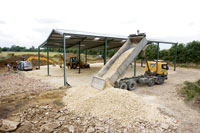Preparation is key for successful loan applications

Looking for a loan? Careful preparation could boost your credit worthiness and persuade your bank you are a risk worth taking. Robert Harris reports
Lending to business may have slowed since the economic crisis broke in 2007, but farming remains very much in favour with the banks.
Agriculture came through the recession pretty well, says Dick Mason, agriculture policy director at Lloyds TSB and Bank of Scotland.
“Land prices have risen and rural property prices have held up quite well. Farming’s bad debt record remains very favourable, so it is certainly attractive in the current climate.”
But increasing volatility means banks are assessing the risk of lending to a particular business more closely than ever.
“We want to lend money, but we want to be sure that it is the right thing for the client, and the right thing for us,” he says.
The process kicks off with a farm visit to assess overall potential. The focus then switches to the applicant. “We want to get an understanding of their ability and track record.
“Putting together a business plan is pretty easy, but is frequently done by a consultant. Implementing the plan is the challenge, and we need to assess the borrower’s ability to do that.
“We used to ask for two or three years of accounts; now we may be asking for four to five to allow for the impact of increased volatility and the effect on profitability, cash generation and balance sheet movement,” says Mr Mason.
“We then compile a balance sheet of the business on the day to assess net worth. After that we like to see budgets and cashflow forecasts – these are not always available, but they could make the difference on more challenging deals.”
Including a sensitivity analysis to allow for greater market volatility is vital – some budgets are drawn up on very favourable figures, he adds.
“Clearly, using a 0.5% base rate and a £160/t grain price is not safe – the first thing we would ask is can this work at 5% and £100/t?”
The next step is to examine the past 12 months bank statements. “We need to assess account conduct – if someone has been in excess of their agreed limits frequently that might be a concern, but there could be mitigating reasons for that.” Statements should be checked well in advance of any meetings so that any excess can be explained clearly.
Owning acres is no longer a guarantee of loan approval, Mr Mason stresses. “We can’t afford to take on a business that will continually need more cash to keep it afloat even if it has a strong balance sheet.”
However security could swing marginal deals and have an impact on interest rate, said Mr Mason.
Despite this closer scrutiny, Lloyds TSB Agriculture has increased farmer lending by 16% over the past 12 months, he says, lending more to existing customers as well as taking on new farming accounts. “There is a good level of investment on many farms, with farmers making good use of competitive rates to expand or upgrade their businesses.”
Mark Ashbridge of Savills Private Finance negotiates borrowing for farmers and other investors from a wide range of sources and confirms the importance of ability to service debt.
“Today’s rates won’t be with us forever. The normal base rate is more like 5%, so that needs to be taken into account when you are working out what the business can afford.” Budgets should also fit in with historical trends for the business.
Accounts going back at least three years will be required. “Identify any anomalies – for example, the area you farm may have increased, there may be structural change or family circumstances may have altered.
“Farmers are quite bullish at the moment. The short-term cost of money is the same as, or even less than, the financial yield from farming, something we have not seen for many years.”
“That means a good farmer might be able to generate a marginal profit before finance of perhaps 3% from farming.” This was in contrast to the historical situation where they had usually bought land as an investment, knowing they would have to take a hit by making less money in the short term.
“Banks are focusing on assets as security. Typically, they are looking for a loan to value ratio of 50 to 70%. But agriculture is low yielding – if you are making 2% profit before finance costs, it is unlikely you will be able to service a loan of 70% of the value of the land unless you can bring in funds from elsewhere.”
Borrowing money – key points:
*More emphasis on risk assessment – prepare
*Commitment and track record important
*Detailed accounts over four to five years required – explain any anomalies or differences between years
*Construct realistic budget and cash flow forecasts – prepare for searching questions on how they work
*Include robust sensitivity analysis
